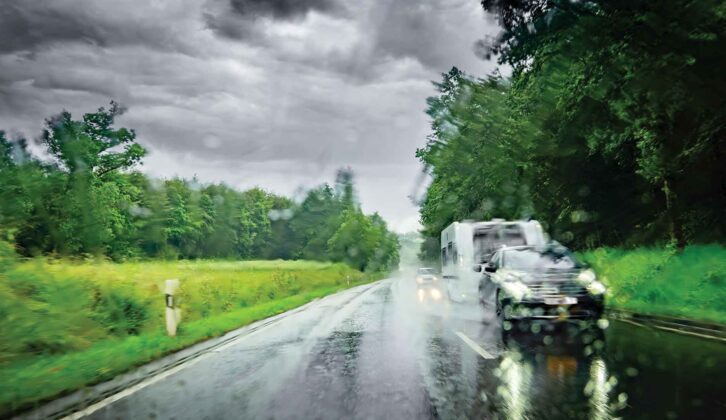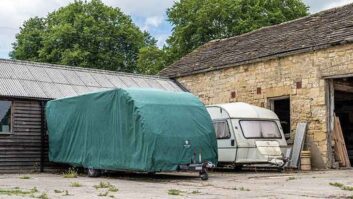Towing a caravan in heavy rain is a fact of life for any British caravanner. The heavens could open at any time of year, whether you prefer touring in the summer months or enjoy some winter caravanning.
The wettest parts of the country receive up to 4m of rain annually. Even the driest areas receive around 500mm per year (that’s about 20 inches in old money).
If you’re towing a caravan for the first time, the thought of facing heavy rain could be another unwanted complication – after all, wet weather will place extra demands on the driver, the car and the caravan. It’s nothing experienced drivers can’t take in their stride, but it pays to be prepared, before and during any towing journey.
Here, I’ll run through the various steps you need to take to make sure that your tow car and tourer are ready for travel in heavy rain. I’ll also offer some tips to help drivers while behind the wheel in wet weather.
Don’t miss my tips on towing a caravan around vulnerable road users either.
Practical Caravan is supported by its audience. When you purchase through links on our site, we may earn an affiliate commission. Learn more
Get your car ready for the rain
Some of the most important steps before towing in wet weather actually take place long before a wheel is turned. You need to be sure your car is ready for whatever the British climate might throw at it.
Tyres are key. It doesn’t matter whether you have a new or used car – by law, the tyres must have 1.6mm of tread depth across the central ¾ of the tread, all the way around the tyres’ circumference. It’s not worth running tyres until they are close to the legal minimum, because they will begin to lose wet-weather grip quite a while before this.
It’s sensible to change the tyre when it is worn down to around 2-3mm of tread depth (from around 8-9mm for a brand new tyre). This is a good compromise between maximising the life of the tyre and making sure you stay safe and legal.
Remember, if the police stop you and find a defective tyre, you face a three-point penalty on your licence and a fine of up to £2500 – and that’s per tyre!
A proper tyre tread depth gauge is ideal, as this lets you know how much tread is remaining. The quick and easy alternative is to measure the remaining tread with a 20p piece. The outer band of the coin should disappear into the tread. If it doesn’t, the tyre is too worn. Remember to check the tread in a few places to make sure there is enough tread all the way around.
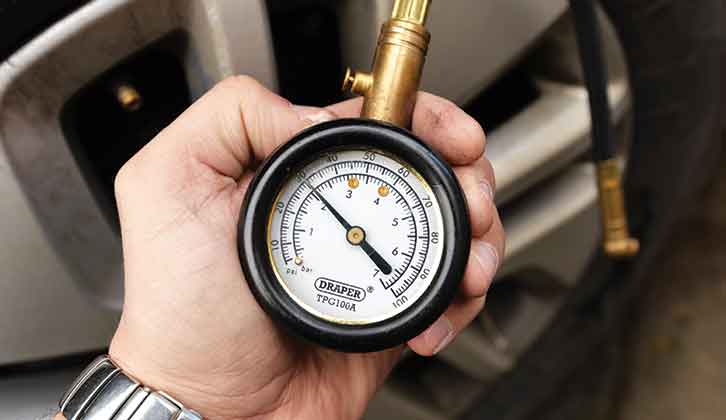
It’s not just a worn tread that could land you in trouble. Regularly check the tyres for any cuts and bulges.
If you do notice evidence of damage, have the tyre inspected by a professional. It will probably need to be replaced.
As part of your regular car maintenance routine and before towing a caravan for a long distance, check the tyres are inflated to the correct pressures.
Remember, these may be different while towing – you’ll probably need a few extra PSI in each tyre compared with everyday driving.
Don’t forget to check the spare if you have one. You’ll kick yourself if you have a puncture and the spare wheel is flat when you need it.
If you have a tyre repair kit instead of a spare wheel, make sure the kit is complete and in date. They generally have a use-by date. You might find the kit still works beyond this, but rather than just crossing your fingers, it makes sense to replace the kit promptly for your peace of mind.
As well as tyres, you need to make sure you can see and be seen in poor visibility. Rain and spray can make it hard to see if your screen isn’t clear.
Check the wiper blades for wear and tear. If the rubber is cracked or pieces are missing, it’s time to fit replacements.
You should also look out for streaks on the screen or squeaking from the blades, which are all signs that the blades are past their best.
Many motor accessory stores will fit replacement wiper blades for you, although it’s a simple enough DIY job.
Top up the fluids
You’ll also want to make sure that the washer fluid is topped up. Ideally, you would change washer fluid depending on the season, because winter and summer fluids have different formulations to suit different conditions. Summer fluid will clear bugs and dust, while winter fluid is formulated for lower temperatures and will help to de-ice a windscreen.
You can also get all-season washer fluids if you would rather use one of these fit-and-forget formulations.
Never let the washer fluid reservoir run completely dry, because it can make it very hard to see clearly, especially when the sun is low in the sky.
A water-repellent treatment such as Rain-X can help to clear the screen, needing fewer sweeps from the wipers.
Lighting up time
It’s important to have clean and effective lights in wet weather. As well as routinely checking your lights, make a point of examining them before a long towing journey, even if you’re only planning to be on the road during daylight hours.
Also, the lights may be working properly, but dirt and grime can make them less effective. If the lights are very dirty, give them a clean before you set off.
Prepare your caravan for towing in the rain
While pre-journey car prep is essential, you should also make sure you prepare your caravan for a tour too.
As with the car, make sure the lights are working and that the lenses are clean and clear.
It doesn’t take a moment to give them a clean, even if they may gradually become dirty again during the journey.
Don’t forget to carry out some caravan tyre safety checks too. Just as with your car tyres, you’ll want to make sure that there are no bulges or cuts and that you have at least 1.6mm of tread all the way around.
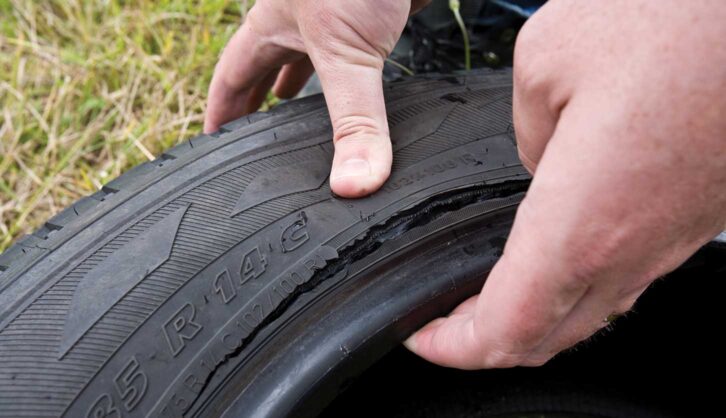
Make sure that the tyres are inflated to the correct pressures. If you’ve been storing the caravan for a while, the pressures might well have dropped considerably.
You should be able to find a sticker on the door telling you the correct pressure, or you can check in the owner’s manual.
Failing that, there are handy online calculators to do the sums, such as the one on the TyreSafe website.
This takes into account the weight of the van, the number of axles, and the tyre size and load index, to provide you with a recommended pressure.
Take a look at our guide to caravan tyre care for more on what you can do to keep the rubber in tip-top condition.
Always leave a safe stopping distance
Preparation won’t count for much without careful driving. In wet weather, it’s important to give yourself plenty of time and space to make decisions and respond to the actions
of other road users.
In regular driving, it’s recommended that drivers should leave a four-second gap to the vehicle in front in wet conditions. This is double the suggested gap in dry weather.
These gaps should be thought of as the bare minimum while towing, to account for the extra stopping distance compared with that of a solo car.
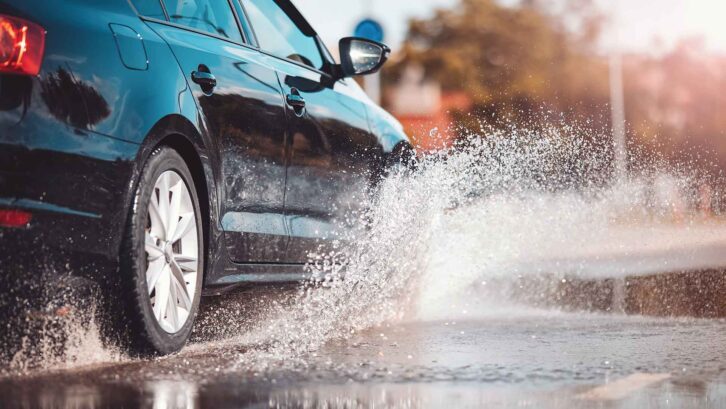
Sometimes, an impatient driver will be very close to the back of your caravan. If you are tailgated while towing in wet weather, don’t be intimidated into driving faster than you judge to be safe.
If anything, you should leave extra space up ahead to allow for the other driver leaving themselves little room to stop.
When to delay travelling
Pay close attention to the weather forecast in the days before travelling. While a bit of rain isn’t going to put you off towing, if heavy rain and high winds combine, it’s prudent to consider altering your plans.
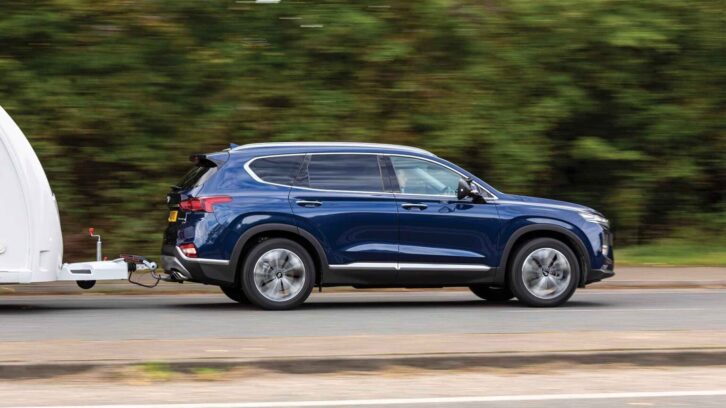
If you can travel a day early or a day late, you could avoid the worst of the weather. But if you do decide to travel, slowing down can make a difference to the stability of car and caravan when it’s wet and windy – even dropping from 60mph to 55mph makes a noticeable difference.
Sometimes, though, it’s best to cancel a trip and rebook. If the Met Office is advising against unnecessary journeys, stay at home instead and put an extra log on the fire.
Checking the route
When travelling in wet weather, especially if it’s windy as well, consider altering your route. For example, it might be better to travel inland rather than taking the Prince of Wales Bridge across the Severn.
A valley route may be better than travelling across exposed high ground in strong winds. The opposite might be true if winds are subdued but the rain is particularly heavy.
Driving through flood water
When heavy rain is forecast, check for flood warnings. Local knowledge is always useful, so call ahead to the campsite and ask them if any of the nearby roads are flooded, so you can avoid them on your trip.
Prevention is definitely better than cure – it’s easy enough to turn around to avoid floodwater in a car, but making a U-turn while towing is stressful.
If other cars are successfully driving through the flood, then you may decide to proceed. If so, be cautious, keep your speed down and stay to the middle of the road, where the water will likely be at its shallowest.
If in any doubt, it’s better to turn around and head another way rather than risk damaging your car and caravan.
The verdict on towing a caravan in the rain
In Britain, we love to complain about the weather. But unless you are travelling in the mountains in winter (in which case you should probably take a look at our tips on how to keep a caravan warm in winter), it is rarely bad enough to stop you towing. Rain – even heavy rain – should not put you off. With the right preparation and careful driving, it would take dire weather to make towing too risky to consider.
Something else you may want to consider when you’re on the road is headlight glare – don’t miss our tips where we talk you through what causes it and the steps you can take to avoid it.
Lead image: Getty Images
Future Publishing Limited, the publisher of Practical Caravan, provides the information in this article in good faith and makes no representation as to its completeness or accuracy. Individuals carrying out the instructions do so at their own risk and must exercise their independent judgement in determining the appropriateness of the advice to their circumstances and skill level. Individuals should take appropriate safety precautions and be aware of the risk of electrocution when dealing with electrical products. To the fullest extent permitted by law, neither Future nor its employees or agents shall have any liability in connection with the use of this information. You should check that any van warranty will not be affected before proceeding with DIY projects.
If you’ve enjoyed reading this article, why not get the latest news, reviews and features delivered direct to your door or inbox every month. Take advantage of our brilliant Practical Caravan magazine SUBSCRIBERS’ OFFER and SIGN UP TO OUR NEWSLETTER for regular weekly updates on all things caravan related.
